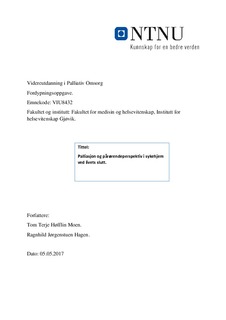| dc.contributor.advisor | Rønsen, Astrid | |
| dc.contributor.author | Moen, Tom Terje Høfflin | |
| dc.contributor.author | Hagen, Ragnhild Jørgenstuen | |
| dc.date.accessioned | 2017-08-09T07:47:34Z | |
| dc.date.available | 2017-08-09T07:47:34Z | |
| dc.date.issued | 2017 | |
| dc.identifier.uri | http://hdl.handle.net/11250/2450229 | |
| dc.description.abstract | Eldre mennesker i Norge opplever å komme på sykehjem når de ikke klarer seg hjemme lengre grunnet dårlig helse. Noen pasienter kommer for å få en god palliativ omsorg ved livets slutt, og dette innebærer også ivaretakelsen av pårørende som er en viktig del av pasienten. Når pasienten er inne i livets sluttfase, vil temaet om å avslutte behandlingen bli aktuelt. Dette medfører at pårørende får en viktig rolle i henhold til beslutningsprosessen, som handler om begrensning av livsforlengende behandling hos pasienten. Hensikten vår med denne oppgaven er å finne ut hvordan pårørende opplever å bli behandlet og ivaretatt i beslutningsprosessen, og at vi kan lære noe av dette. Metoden vi har brukt er litteraturstudie og oppgaven har utgangspunkt i de 5 artiklene vi har funnet. Resultatet vårt viser at pårørende føler at de ikke blir ivaretatt og må ta avgjørelser som de ikke er komfortabelt med. I tillegg opplevde de dårlig kommunikasjon med helsepersonell og at det oppsto konflikter både i familien og med helsepersonell. Det var få av pårørende som hadde innsikt og kunnskap om beslutningsprosessen ved livets slutt. Konklusjonen vår bygger på at det er et forbedringspotensial innen kommunikasjon hos de ulike partene. Både pasient og pårørende bør bli sett og hørt, da dette er av stor betydning. Pasientene selv var opptatt av sin autonomi og selvbestemmelse, at dette måtte bli respektert. Ut ifra flertallet av pårørende, er det ønskelig å bli involvert tidlig og bli informert om beslutningsprosessen. | nb_NO |
| dc.description.abstract | Older humans in Norway experience coming at a nursing home when they can’t live at home anymore because of bad health. Some patients comes to get a good palliative care of the end of life, and this also means the preservation of relatives that is an important part of the patient. When the patient is in the end of life, the topic about quitting the treatment is relevant. This leads to relatives get an important role in the decision-making process, which is about limitation of life prolonged treatment in the patient. Our purpose with this task is to find out how relatives experience to be treated and taken care of in the decision-making process, and that we can learn something of this. The method we have used is literary study and the assignment is based on the 5 articles we have found. Our result shows that relatives feel that they are not taken care of and must make decision they are not comfortable with. In addition, the experience bad communication with healthcare professionals and those conflicts occurred both in the family and with healthcare professionals. There were a few of relatives who had the intention and knowledge of the decision-making procession at the end of life. Our conclusion is that it is an improvement potential in communication with the various parts. Both patient and relatives should be seen and heard, as this is a great importance. Patients themselves were concerned with his own anatomy and self-esteem that this needs to be respected. Out of the majority of relatives, is it desirable to get involved early and informed about the decision-making process. | nb_NO |
| dc.language.iso | nob | nb_NO |
| dc.subject | Pårørende | nb_NO |
| dc.subject | Beslutningsprosessen | nb_NO |
| dc.subject | Sykepleie | nb_NO |
| dc.subject | Kommunikasjon | nb_NO |
| dc.subject | Relatives | nb_NO |
| dc.subject | Decision-making process | nb_NO |
| dc.subject | Nursing | nb_NO |
| dc.title | Palliasjon og pårørendeperspektiv i sykehjem ved livets slutt. | nb_NO |
| dc.title.alternative | Palliation and relatives perspective in nursing homes at the end of life. | nb_NO |
| dc.type | Student paper, others | nb_NO |
| dc.subject.nsi | VDP::Medical disciplines: 700::Health sciences: 800::Nursing science: 808 | nb_NO |
| dc.source.pagenumber | 43 | nb_NO |
